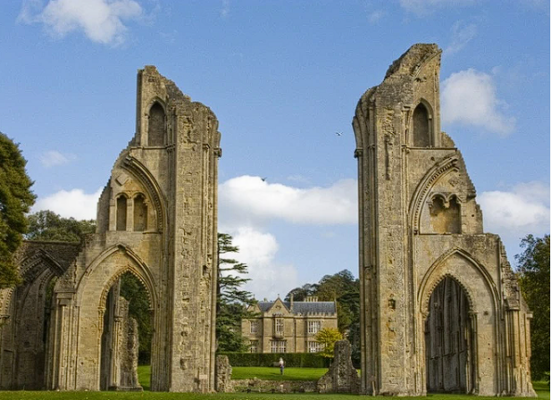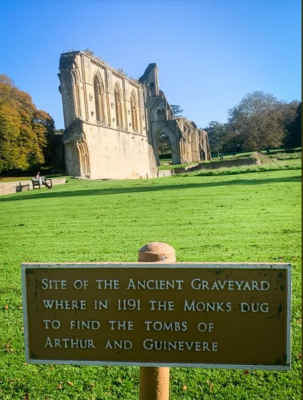Glastonbury, a town steeped in history and legend, is one of the most intriguing locations associated with King Arthur. Myths and tales of the legendary ruler have swirled around this ancient site for centuries, drawing historians, archaeologists, and Arthurian enthusiasts alike. While the true existence of King Arthur remains debated, Glastonbury’s connection to the legend continues to captivate visitors from around the world.
The Arthurian Connection to Glastonbury
Glastonbury Abbey and the Discovery of Arthur’s Grave
One of the most famous claims linking King Arthur to Glastonbury dates back to the late 12th century when monks at Glastonbury Abbey reportedly discovered his grave. According to historical accounts, while excavating the grounds, the monks uncovered a stone slab inscribed with the words “Here lies Arthur, King,” alongside skeletal remains believed to belong to Arthur and his queen, Guinevere.
This discovery came at a time when King Henry II was eager to strengthen the influence of Glastonbury Abbey, leading some scholars to believe the find was a strategic move to attract pilgrims and prestige. Regardless of the motivations, the claim cemented Glastonbury’s place in Arthurian lore.
The Reburial and Pilgrimage Site
After their discovery, the supposed remains of King Arthur and Guinevere were ceremoniously reinterred within the abbey in 1278 under the orders of King Edward I. The new tomb became a major pilgrimage site, with thousands visiting to pay their respects to the legendary ruler. Today, though the original remains have long since disappeared, visitors can still see the marked location of the supposed grave within Glastonbury Abbey’s ruins, adding to the town’s mystical allure.

South Cadbury Hill: The Possible Camelot
Archaeological Evidence at South Cadbury Hill
Just a short distance from Glastonbury, South Cadbury Hill has long been associated with Camelot, Arthur’s fabled stronghold. Archaeological excavations in the 20th century revealed that the site was occupied during the 6th century—the most likely period in which a historical Arthur may have lived.
Findings at the site include evidence of a substantial fortress with extensive defenses, suggesting it was a place of significant power during the Dark Ages. These discoveries have led some historians to speculate that South Cadbury could indeed have been the real-life Camelot.
The Mystical Aura of Cadbury Castle
Beyond archaeology, South Cadbury Hill, also known as Cadbury Castle, is deeply embedded in Arthurian legend. Local folklore speaks of Arthur and his knights riding out from beneath the hill, and some believe that on certain nights, one can still hear the sounds of horses and battle echoes on the wind. Whether fact or fiction, the site remains one of the most compelling Arthurian locations in Britain.

The Glastonbury Tor and the Isle of Avalon
The Tor: A Portal to Another World
One of the most mystical landmarks in Glastonbury is the Tor, a striking hill crowned by the ruins of St. Michael’s Tower. This site has long been associated with the Isle of Avalon, the legendary resting place of King Arthur.
Ancient tales describe Avalon as a place of healing and magic, where Arthur was taken after his final battle. Some believe that beneath the Tor lies an entrance to this fabled island, hidden in another realm. The association with Avalon only strengthens Glastonbury’s reputation as an Arthurian hotspot.
Legends of the Holy Grail
Glastonbury is also tied to the legend of the Holy Grail, the sacred chalice from Arthurian legend. Some stories suggest that Joseph of Arimathea, who is said to have brought Christianity to Britain, also brought the Grail to Glastonbury. The Chalice Well, a spring at the foot of Glastonbury Tor, is rumored to be connected to this legend, with its red-tinged waters symbolizing the blood of Christ.
The Enduring Legacy of King Arthur in Glastonbury
A Tourist and Pilgrimage Destination
Today, Glastonbury continues to be a major destination for those fascinated by Arthurian legend. Tourists, historians, and spiritual seekers visit the town to explore its ancient ruins, walk its mystical hills, and experience the rich history that intertwines fact and folklore.
The Debate Over Arthur’s Historical Existence
While many scholars debate whether King Arthur was a real historical figure or merely a literary creation, the legends surrounding him remain powerful. Glastonbury, with its blend of history and myth, stands as a testament to the enduring appeal of one of Britain’s greatest legends.
Whether one believes in the historical Arthur or not, Glastonbury’s landscapes, ancient ruins, and folklore continue to inspire wonder and curiosity. The town remains a place where history and legend merge, inviting visitors to step into a world where the past still whispers its secrets.

CÁC TIN KHÁC
Mary Walton: The Forgotten Inventor Who Helped Clean Up America’s Cities
Tomb of Queen Nefertari in the Valley of the Queens, Egypt
Discover the Hypostyle Hall of the Temple of Hathor at Dendera
Venus de Losange: Unveiling the Mystery of a 20,000-Year-Old Paleolithic Icon